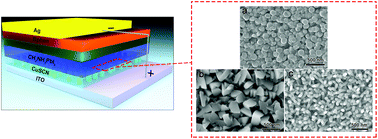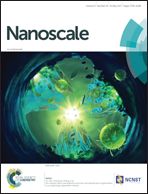Highly efficient inverted solar cells based on perovskite grown nanostructures mediated by CuSCN†
Abstract
In this work, three different CuSCN nanostructures (NSs), hexagonal prism-like (3D), pyramid-like (2D) and nanowire structures (NWs) are first applied to inverted heterojunction perovskite solar cells as p-type inorganic hole transport layers (HTLs) using a moderate electrodeposition method at room temperature. It is revealed that the crystal structure and the thickness of the CuSCN layer can dramatically regulate the morphology and the crystal orientation behavior of perovskite absorbing layers, which will further have a significant influence on the following device performance. Compared with the other two nanostructured CuSCN HTLs, devices based on 3D structured CuSCN HTLs exhibit better performance mainly attributed to the high crystalline quality of perovskite films controlled by the well-oriented hexagonal prism-like nanostructures of CuSCN. After optimization, a maximum power conversion efficiency (PCE) of 11.40% has been obtained with 3D CuSCN which has a thickness of 200 nm. It is the highest value among the current reports using nanostructured CuSCN as an inorganic HTL in inverted PSCs. The dominating effect of CuSCN nanostructures on the crystal quality of perovskites provides guidelines for future material optimization and device efficiency enhancement.



 Please wait while we load your content...
Please wait while we load your content...